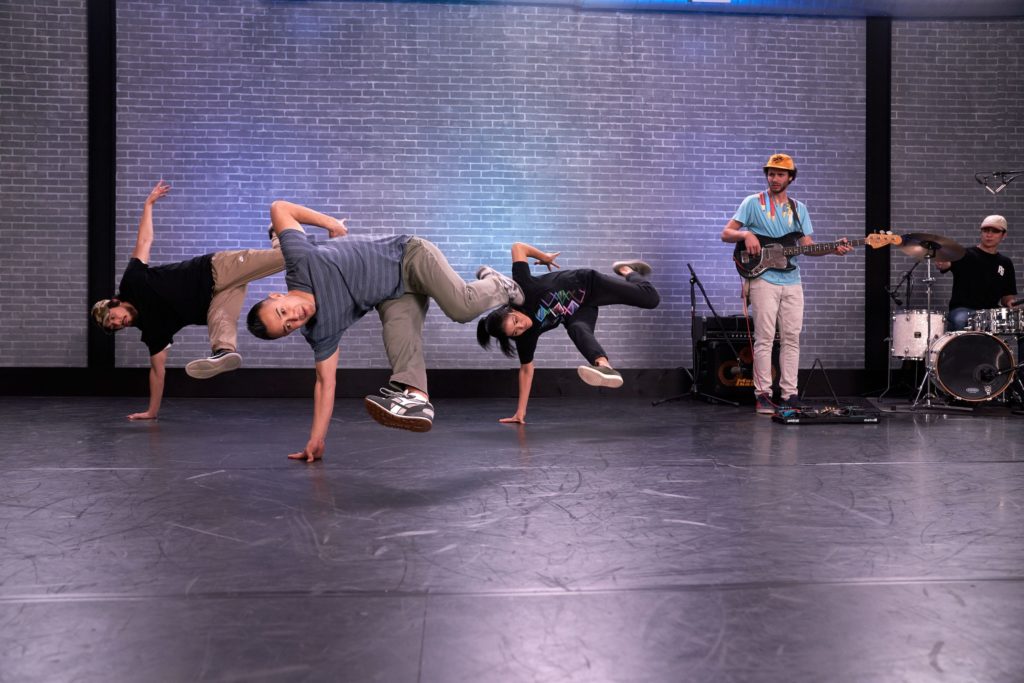Hip-hop dance–like hip-hop music–has a lexicon full of specific slang which might be a bit confusing for the casual observer or new student. Don’t worry though, that’s exactly who we had in mind when we compiled this quick glossary of common hip-hop dance terms. You may notice some overlap here with hip-hop as a musical genre, which goes to show the tight relationship between the music and the motion.
Breakdancing/ B-Boys/ B-Girls
Breakdancing is the visual expression of hip-hop, and was spontaneously created and developed in the exact same cultural landscape: New York in the late 1970’s. Taking its name from Bronx DJ Kool Herc, break dancing was originally what happened during the percussion breaks of early hip-hop tracks. The dancers were first called “break boys,” which was then shortened to b-boys and b-girls. Breakdancing contains four main types of movements: toprock (moves performed while upright), downrock (moves performed on the floor or on a cardboard mat), freezes (moves that are held or posed) and power moves (moves which contain an explosive or gymnastic element designed to wow the audience).
Fundamentals
This comes to us from the streets of New York City and the dawning era of hip-hop: The late 1970’s and early 1980’s. During that time of intense innovation, the four fundamental pillars of hip-hop culture were developed: DJ-ing, Rapping, Graffiti, and Break Dancing. These four modes of expression are stylistic ground zero for all hip-hop culture.
8 Count
This is the core of hip-hop dance, as like many other genres, most movements in hip-hop dance are choreographed into eight beat sections. A quick explanation: Most music is in 4/4, or “common time.” That means that in one measure there will be four equally-sized quarter notes to count the time. Try clapping four times in rhythm, that’s a 4/4 measure. You might have noticed that’s not quite enough time to track a full section of dance moves, so double it, and you’ve got an eight count.
Breaks
Breaks are sections of a track in which all of the parts in the track–vocals, melody, samples–cut out and only the beat remains. Think of them like drum breaks, or percussion solos.
Street Dance
This refers to the dances which developed independent of studio or dance production choreography. Often influenced by African dances, many street dances have origins going back to the mid-20th century. Street dance is an umbrella term which has, for the most part, been incorporated under the umbrella genre of hip-hop dance. Examples of street dance include popping, locking, and breakdancing.
Popping
A street dance which originated in the Oakland Bay Area in the 1960’s, popping is usually easily identifiable by the quick-contraction, exaggerated movements usually performed on the arms and legs. Often paired with “locking,” (although the two have different origins) popping is distinct from hip-hop dance but still used in hip-hop dance, and is very influential to its development.
Locking
Created by the choreographer Don Campbell in Los Angeles in the late 1960’s, locking is a form of freezing during which the dancer strikes a certain pose–often physically improbable or intensely contorted–to emphasize a passage of music or structure of the dance in general. Considered a street dance, it is often paired with popping in hip-hop dance, although both styles have earlier origins.
Freestyle
Similar to “freestyling” in hip-hop, freestyle in hip-hop dance is when a dancer or dancers take over a section of the beat to bust out some improvisational moves. It’s the kinetic, visual version of grabbing the mic for a few bars.
Cypher
A cypher is when a group of dancers form a circle and take turns freestyling in the center. In hip-hop culture, cyphers are an important way of showing off your skills and honing your abilities in the face of instant peer review and critique.
DJ
The master of the music, the turntablist, the person who provides the sounds for the players. DJ is an honorific for the person spinning the records and producing the music, either live or otherwise. Shortened from deejay or “disc jockey,” the DJ works hard to supply the beats for the people.

